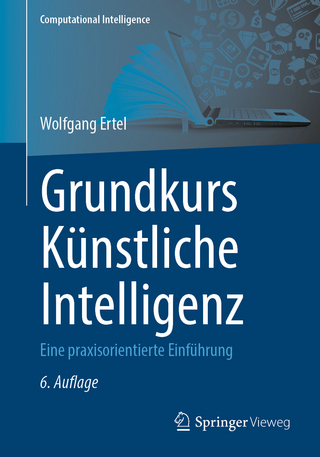
An Introduction to IoT Analytics
Seiten
2021
Chapman & Hall/CRC (Verlag)
978-0-367-68631-4 (ISBN)
Chapman & Hall/CRC (Verlag)
978-0-367-68631-4 (ISBN)
This book covers techniques that can be used to analyze data from IoT sensors and also addresses questions regarding the performance of an IoT system. It strikes a balance between practice and theory so that one can learn how to apply these tools in practice with a good understanding of their inner workings.
This book covers techniques that can be used to analyze data from IoT sensors and addresses questions regarding the performance of an IoT system. It strikes a balance between practice and theory so one can learn how to apply these tools in practice with a good understanding of their inner workings. This is an introductory book for readers who have no familiarity with these techniques.
The techniques presented in An Introduction to IoT Analytics come from the areas of machine learning, statistics, and operations research. Machine learning techniques are described that can be used to analyze IoT data generated from sensors for clustering, classification, and regression. The statistical techniques described can be used to carry out regression and forecasting of IoT sensor data and dimensionality reduction of data sets. Operations research is concerned with the performance of an IoT system by constructing a model of the system under study and then carrying out a what-if analysis. The book also describes simulation techniques.
Key Features
IoT analytics is not just machine learning but also involves other tools, such as forecasting and simulation techniques.
Many diagrams and examples are given throughout the book to fully explain the material presented.
Each chapter concludes with a project designed to help readers better understand the techniques described.
The material in this book has been class tested over several semesters.
Practice exercises are included with solutions provided online at www.routledge.com/9780367686314
Harry G. Perros is a Professor of Computer Science at North Carolina State University, an Alumni Distinguished Graduate Professor, and an IEEE Fellow. He has published extensively in the area of performance modeling of computer and communication systems.
This book covers techniques that can be used to analyze data from IoT sensors and addresses questions regarding the performance of an IoT system. It strikes a balance between practice and theory so one can learn how to apply these tools in practice with a good understanding of their inner workings. This is an introductory book for readers who have no familiarity with these techniques.
The techniques presented in An Introduction to IoT Analytics come from the areas of machine learning, statistics, and operations research. Machine learning techniques are described that can be used to analyze IoT data generated from sensors for clustering, classification, and regression. The statistical techniques described can be used to carry out regression and forecasting of IoT sensor data and dimensionality reduction of data sets. Operations research is concerned with the performance of an IoT system by constructing a model of the system under study and then carrying out a what-if analysis. The book also describes simulation techniques.
Key Features
IoT analytics is not just machine learning but also involves other tools, such as forecasting and simulation techniques.
Many diagrams and examples are given throughout the book to fully explain the material presented.
Each chapter concludes with a project designed to help readers better understand the techniques described.
The material in this book has been class tested over several semesters.
Practice exercises are included with solutions provided online at www.routledge.com/9780367686314
Harry G. Perros is a Professor of Computer Science at North Carolina State University, an Alumni Distinguished Graduate Professor, and an IEEE Fellow. He has published extensively in the area of performance modeling of computer and communication systems.
Harry G. Perros is a Professor of Computer Science at North Carolina State University, an Alumni Distinguished Graduate Professor, and an IEEE Fellow. He has published extensively in the area of performance modelling of computer and communication systems, and in his free time he likes to go sailing and play the bouzouki.
1. Introduction 2. Review of Probability Theory 3. Simulation Techniques 4. Hypothesis Testing 5. Multivariable Linear Regression 6. Time Series Forecasting 7. Dimensionality Reduction 8. Clustering Techniques 9. Classification Techniques 10. Artificial Neural Networks 11. Support Vector Machines 12. Hidden Markov Models
| Erscheinungsdatum | 25.01.2021 |
|---|---|
| Reihe/Serie | Chapman & Hall/CRC Data Science Series |
| Zusatzinfo | 24 Tables, color; 186 Illustrations, color |
| Sprache | englisch |
| Maße | 178 x 254 mm |
| Gewicht | 700 g |
| Themenwelt | Informatik ► Theorie / Studium ► Künstliche Intelligenz / Robotik |
| Mathematik / Informatik ► Informatik ► Web / Internet | |
| ISBN-10 | 0-367-68631-7 / 0367686317 |
| ISBN-13 | 978-0-367-68631-4 / 9780367686314 |
| Zustand | Neuware |
| Informationen gemäß Produktsicherheitsverordnung (GPSR) | |
| Haben Sie eine Frage zum Produkt? |
Mehr entdecken
aus dem Bereich
aus dem Bereich
Eine praxisorientierte Einführung
Buch | Softcover (2025)
Springer Vieweg (Verlag)
CHF 53,15
Künstliche Intelligenz, Macht und das größte Dilemma des 21. …
Buch | Softcover (2025)
C.H.Beck (Verlag)
CHF 25,20
Buch | Softcover (2025)
Reclam, Philipp (Verlag)
CHF 11,20


